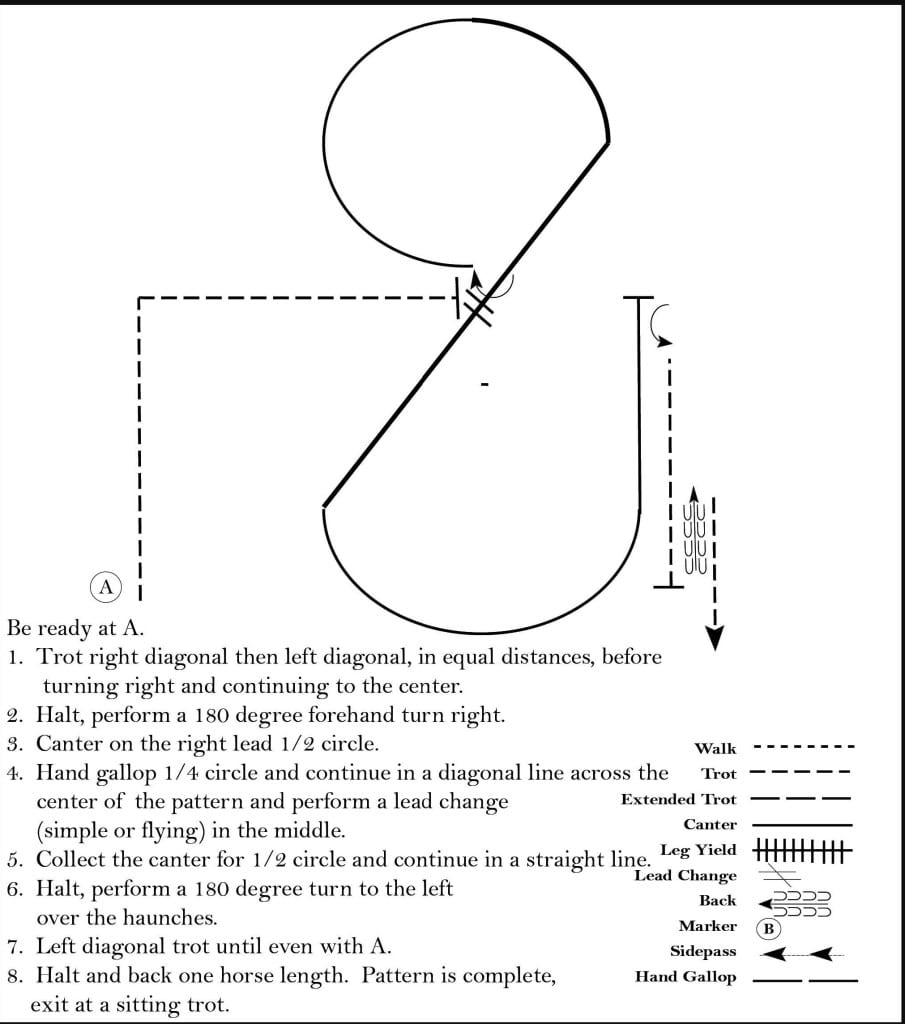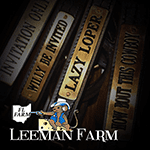Next up on our pattern breakdown is Equitation from our very own Stephanie Lynn. She has been writing for GoHorseShow for two years and has coached, judged and trained riders across divisions for over 35 years. This is Stephanie’s third time to judge the Congress. She holds cards with AQHA, APHA and NSBA and has officiated at each of their World Championship shows and well as other major events across the country.
We would like to thank HorseShowPatterns.com for allowing us to post the pattern in this article as well as provide a link to the pattern. You may view the pattern that is posted below or click here to download. GoHorseShow chose the Equitation 12-14, 15-18, Amateur and Amateur Select as they share the same pattern and we find the other classes often share similar maneuvers.
Equitation 12-14, 15-18 and Amateur as seen by Stephanie Lynn:
I love it when a pattern starts by stating, “Be ready at A.” It seems so obvious but it is good advice. You should know your horse and know how to keep him or her comfortable at A while you wait for the judges to nod you on course. Do not make the judges wait for you. The Congress does an excellent job of getting riders into the pen. Be respectful of the ring staff and be at the start cone ready to go when the judges look up.
With just a start cone, it will be important to go look at the arena and preferably ride in the appropriate arena to find your centers. The exact location of the start cone will not matter so much when you know where the center is. Preplanning is an important part of a good performance.
Judges expect you to be connected to your horse. Riders who appear propped in the saddle or are stiff will receive lower marks even with very precise footwork from their horse. Patterns are intended to test the rider’s connection with their horse. Judges are looking for those riders who they feel have the best connection with their horse – they are looking for great partners who ride in sync with their horse through every step of the pattern. To do this properly requires a connection from the rider’s seat and leg – one that creates the horse’s forward motion and pushes the horse into the rider’s hands – hands that should be the ending point not the starting point of a great ride.
 1. Trot right diagonal then left diagonal, in equal distances, before turning right and continuing to the center. You will start with the cone on your left. Your reins should be properly adjusted so you have contact from the first step. Judges will expect you to know your diagonals. Missing or looking for your diagonal will be penalized according to the severity. Riders who rise on the correct diagonal as the horse steps into the trot while keeping their eyes forward and focused will earn the most credit. Trotting on each diagonal in equal distances requires pre-planning and a good eye once on course. Judges will give you one stride either direction to change your diagonal but more than that and you will be considered early or late.
1. Trot right diagonal then left diagonal, in equal distances, before turning right and continuing to the center. You will start with the cone on your left. Your reins should be properly adjusted so you have contact from the first step. Judges will expect you to know your diagonals. Missing or looking for your diagonal will be penalized according to the severity. Riders who rise on the correct diagonal as the horse steps into the trot while keeping their eyes forward and focused will earn the most credit. Trotting on each diagonal in equal distances requires pre-planning and a good eye once on course. Judges will give you one stride either direction to change your diagonal but more than that and you will be considered early or late.
The corner appears square and this may present a problem for bigger horses. What is important here is that the rider keep the horse positioned properly through the corner. The turn should be fluid – never forfeit correctness for speed or handiness. The rider will earn credit for keeping their horse properly shaped through the corner and maintaining a straight line before and after the corner. A loopy corner will not earn credit. Maintain good eye contact as you ride forward. You most likely will be facing the panel of judges but do not be intimidated or let your eyes drop here. Your posture, including your eyes, portrays your confidence.
2. Halt, perform a 180 degree forehand turn right. Keeping your eyes forward and stopping squarely will earn the most credit. Judges are not looking for the horse to stop hard but to stop correctly, on their hindquarters. Riders whose toes point down during the stop will lose credit. A rider who obtains an obedient stop, straight and square, will earn credit. Riders who transition quickly from a square stop to a turn on the forehand will earn more credit than the rider who has to settle their horse after the stop prior to making the turn. It is a positive reflection on the rider when the horse to moves willingly without resistance. The horse should maintain a slight tip of the nose to the right and the front legs should remain in the same square landing area of the stop. The turn on the forehand is not a spin, so maintaining a pivot leg is not necessary to earn credit.
3. Canter on the right lead ½ circle. The horse should be properly shaped for the right lead after the turn on the forehand but may try to take a sideways step before stepping into the canter. Keep the horse between your rein and leg as you step into the right lead for a clean credit earning departure. It is up to you to determine how big or small to make your circle. Keep it symmetrical and not so large that you get close to the arena walls. This circle should be close in circumference to the circle you will make on the other end of the pattern.
4. Hand gallop ¼ circle and continue on a diagonal line across the center of the pattern and perform a lead change (simple or flying) in the middle. When moving into the hand gallop, it is important that your reins are appropriately shortened. Whether or not you have to physically shorten your rein depends on your horse’s head and neck carriage. A horse with a higher neck carriage will require less shortening of the rider’s rein. Horses with lower neck carriages will require the rider to shorten their rein in order to have their hands in the correct position. This is the place that a rider’s connection and position will be tested the most.
The most connected riders balance from their weight deep into their heel. They do not prop on their toes, standing straight up in their tack. Well-balanced riders keep their seat out of but close to their tack, with their hips balanced over their heels. Riders who balance off their toes will not earn credit. Riders’ hands should be close to the horse’s neck but not resting on the neck. A rider that maintains the proper line from their elbow to the horse’s mouth is in the correct position. This is where your pre-planning comes into play for a credit earning lead change. Ideally, the lead change happens exactly where you performed the turn on the forehand. The rider who maintains the same pace, cadence and line through the change earns credit.
For me, if you do a simple lead change, bringing your seat back to the saddle through the change is acceptable but your hip angle should remain closed as if in a two-point. This allows you to return quickly to your hand gallop and still be in the correct position. Whatever kind of change you make, keep your horse straight through the lead change – do not allow the lead change to carry your horse to the left.
5. Collect the canter for ½ circle and continue in a straight line. Your seat should remain out of the saddle until you begin the arc of your collected canter on the left lead. Your horse should naturally collect when you return to a three-point, seated, position in the saddle. While judges are looking for a change in pace, it is important to keep your horse’s canter forward. Going too slow is a fault and will be scored accordingly. The arc should be roughly similar to the arc you made on the top end with the right lead circle. Coming out of the corner into the straight line, keep the horse between your rein and leg to earn the most credit. Don’t be distracted or let your horse fade or slow as he or she turns from the gate.
6. Halt, perform a 180 degree turn to the left over the haunches. Again judges are looking for a smooth, square stop. Remember, for a hunter, anytime the horse moves backwards from leg pressure it is considered a negative trait, a fault. The rider’s legs should maintain the correct position and feel against the horse’s sides during the stop. Toes should not point down. Balance, correctness and a good connection evidenced through the horse’s obedience is what we are looking for. In the turn on the haunches, the horse should move his or her shoulders and front legs freely away from the rider’s leg. This is not a spin but a test to make sure riders can control both ends of their horse. Trying to go too fast can end up in an overturn.
7. Left diagonal until even with A. You will likely be in front of the judges here. Stay strong and maintain your posture while rising on the left diagonal. A strong finish includes holding your eyes forward through these last maneuvers. Although it is acceptable walk a step prior to the trot, taking three or four walk steps may result in a negative maneuver score. This is a short distance maneuver – showing a working trot with the horse moving forward between your rein and leg all the way to the stop earns the most credit.
8. Halt and back one horse length. Pattern is complete exit at a sitting trot. Try not to look at A before you stop and back. Keep your eyes forward and focused on where you are going. Again, the stop and back should not be hard and fast. Instead it should be obedient and square with the horse willingly moving backwards off the rider’s aids. The pattern is not complete until you exit at the sitting trot. Keep in mind you are always being judged, so keep showing your horse.
Have fun. Regardless of the outcome enjoy the show, the ride, the experience and most of all your horse. Appreciate all the opportunities horses provide. Every time you step up to the cone or enter the arena, remember the judges are rooting for you. They want to see you having fun and enjoying the experience of showing your horse..









